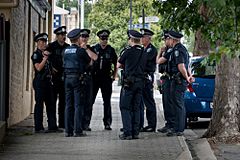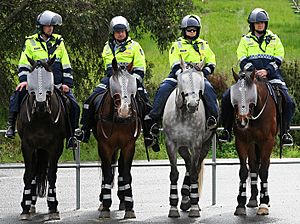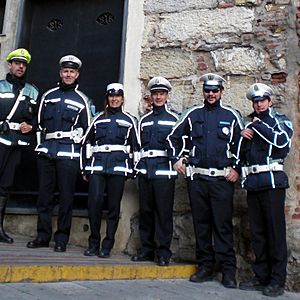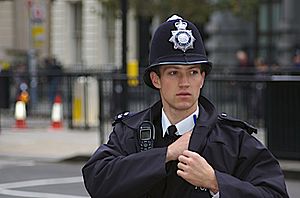Police officer facts for kids

Police officers in Mount Barker, South Australia
|
|
| Occupation | |
|---|---|
|
Activity sectors
|
Law enforcement, public safety, civil service, public service rescue, protection of private property |
| Description | |
|
Education required
|
Secondary or tertiary education |
|
Fields of
employment |
Public areas |
|
Related jobs
|
gendarmerie, military police, security guard, bodyguard |
A police officer is someone who works for the police. Their main jobs are to stop crime, help people, and keep things orderly and safe. They have special legal powers to do their job, like being able to arrest people. In places like Britain, these powers are called a warrant.
Contents
What Police Officers Do
Police officers have many different jobs. What they do can change a lot depending on the country or even the city. Usually, they help keep the peace, make sure laws are followed, protect people and their belongings, and investigate crimes. They need to be ready for all kinds of situations when they are working.
There are rules about how officers should act in the community. In many places, there are also rules about what a uniformed officer wears. In some countries, police officers must act if they see a crime happening, even if they are not on duty. Police officers almost always keep their legal powers even when they are off duty.
In most Western countries, the main job of the police is to keep order. They do this by watching the public and finding people who might be breaking the law. They also try to stop crimes from happening by being visible in the community. Most police forces have teams that investigate crimes. Police officers have the legal power to arrest and hold people, usually with permission from a judge. They also respond to emergency calls and work with communities.
Police as Emergency Helpers
Police officers often work as an emergency service. They help keep people safe at big events and during emergencies, disasters, and search and rescue situations. They also respond to car accidents. To help quickly in emergencies, police often work with firefighters and medical emergency teams. In some countries, people can be both police officers and firefighters. Many countries have one easy emergency number to call for police, fire, or medical help.
Police officers also give out tickets for smaller offenses, like breaking traffic laws. These tickets often lead to fines. Officers on motorcycles, called motor officers, often handle traffic enforcement. Police are also trained to help people in trouble, like drivers whose cars have broken down or people having a medical emergency. Police officers usually know basic first aid, like CPR.
Some park rangers are also law enforcement officers. They help enforce laws in national parks and other outdoor areas. Military police officers do similar jobs within the military. Teenagers interested in this career can join a local police Explorer program.
Becoming a Police Officer
In most countries, people who want to join the police force need to have finished a certain level of schooling. More and more people are joining the police with college degrees. Because of this, many police forces have "fast-track" programs. These programs allow people with university degrees to become Constables for a few years before being promoted to higher ranks, like Sergeants or Inspectors. Officers who work in investigation or plain clothes do not always have a higher rank; they just have different duties. Police officers are also recruited from people who have worked in the military or security. In the United States, state laws might set rules for age, education, criminal record, and training. But in other places, local police groups set their own rules.
Getting promoted is not automatic. It usually means passing an exam, an interview, or other selection steps. While a promotion usually means more salary, it also means more responsibility and often more paperwork. Experienced patrol officers are highly respected.
After about two years of service, officers can often apply for special jobs. These include being a detective, a police dog handler, a mounted police officer, a motorcycle officer, a water police officer, or a firearms officer (in countries where police do not usually carry guns).
Police Equipment
Police officers in different countries use different equipment to deal with crime. Most police officers carry tools they can use to defend themselves or others. Common items include:
- A gun or a baton/truncheon, which can be used to injure or, if needed, stop criminals.
- A canister of CS gas or pepper spray, which can temporarily blind a person.
- A set of handcuffs, for holding a person safely.
- A protection vest, to keep the officer safe from knives and guns.
- A flashlight, for seeing in dark places.
- A two-way radio, to call for help, share information, and get backup.
Police officers need to patrol and respond to emergencies quickly. Some officers walk on foot patrol, but often they patrol in a police car. This helps them get to emergencies faster and carry more equipment. Sometimes officers patrol on bicycles, motorbikes, or horses if they work in those special units.
Related Pages
Images for kids
-
A German state police officer in Hamburg.
-
The New York Police Department (NYPD) is the largest police force in the United States. In 2018, it had 38,442 uniformed officers.
-
A Royal Canadian Mounted Police officer in their special dress uniform.
See also
 In Spanish: Agente de policía para niños
In Spanish: Agente de policía para niños










